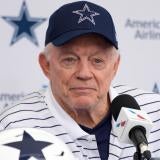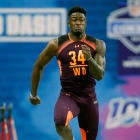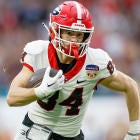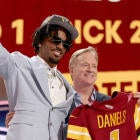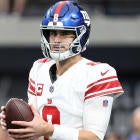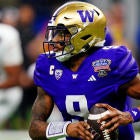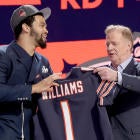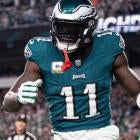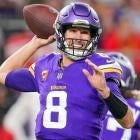No Doug Baldwin in Seattle is going to be weird.
While his absence won't be quite as jarring as the recent departures of Legion of Boom members, Baldwin was a steady force in the Seahawks' passing game from the moment he stepped onto the field in 2011.
Of the 45 receivers who've seen at least 500 targets since Baldwin's rookie year, his 9.09 yards-per-target average ranks seventh.
Seattle will have to replace an underrated star at receiver this season.
Following Baldwin's retirement, Tyler Lockett will step into the Seahawks' No. 1 wideout role after arguably the most epic yet unheralded receiving seasons in modern NFL history. For real. Locked turned 70 targets into 57 receptions, 965 yards (13.8 yards per target), and 10 touchdowns. A masterpiece.
But he's going to need some help out wide, especially with what'll likely be added attention his way.
As the CBS Sports' summer series examining training camp position battles moves forward, let's analyze the main candidates to make sizable impacts at the receiver spot in Seattle during the 2019 season.
Check out all our training camp battle stories here.
The Veterans
David Moore
Moore played 58 percent of the offensive snaps in 2018 and was a real deep threat even if he only ended with 26 receptions. He averaged 17.1 yards per grab and scored five times in his second season.
Of all the receivers to see at least 40 targets last season (Moore saw 52) he had the third-highest average depth of target -- 17.4 yards -- trailing only Buffalo's Robert Foster and Tampa Bay's DeSean Jackson, per AirYards.com.
Moore was snagged by the Seahawks in the seventh round of the 2017 Draft of East Central (OKLA) after opening eyes at his pro day running 4.42 at 6-foot-1 and 219 pounds. His size and speed combination is precisely what GM John Schneider looks for throughout the draft at the receiver spot, which is probably why the team was willing to take a late-round flier on a small school prospect.
After a four-grab, 103-yard, one-score performance in a win against Carolina in late November -- his best effort of the 2018 season -- Moore had just four more receptions for 32 yards over the final five games of the year.
The third-year pro probably did enough to begin camp as one of the team's first-string wideouts in three-receiver sets. And I think he's in for another low-volume, high-efficiency year with the Seahawks. You can call him a deep sleeper in fantasy.
Jaron Brown
Brown appeared on 32.9 percent of the Seahawks' offensive snaps last season. He only caught 14 passes on 19 targets for 166 yards but did score five touchdowns. That's quite the touchdown-to-reception ratio.
The former undrafted free agent has just 100 grabs in his six NFL seasons to date, and while a career 13.4 yards-per-attempt average indicates Brown can stretch the field, he's cemented as a low-volume option. The most grabs he's had in a single season is 31.
There's nothing terrible about Brown's game. There's just nothing remotely spectacular about it. Mainly because of his NFL experience and decent showing last year, he'll begin camp penciled in as Seattle's No. 2 or No. 3 wideout. But I don't think the job will be handed to him this summer. And he's got plenty of competition now. If cut, the Seahawks would save $2.75 million with less than $1M in dead cap.
Amara Darboh
After an illustrious career at Michigan, Darboh crushed his combine workout. MockDraftable.com, a site that tracks historic combine data and provides "comparables" for all participants based on size and measured athleticism, listed DeVante Parker, Quincy Enunwa, and Kenny Golladay as three of the top five comparables for Darboh.
At 6-2 and 214 pounds, he ran a blistering 4.45, had an solid 36-inch vertical, and an impressive 124-inch broad jump.
After being picked in the third round of the 2017 Draft by the Seahawks -- another example of Schneider prioritizing athleticism -- Darboh made just eight grabs for 71 yards as a rookie and was actually traded to the Patriots in early September of last year but reverted back to Seattle following a failed physical in New England.
Darboh had a flair for the acrobatic reception with the Wolverines and posted a respectable 31.2 percent receiving-yard market share in Ann Arbor as a senior in 2016. (Anything above 30 percent is good).
There's refined talent and plus athleticism to Darboh's game. But it's doubtful the Seahawks can rely on him to make a major contribution in Year 3, although a few splash plays wouldn't shock me. I also wouldn't be shocked if he doesn't make the team.
The Rookies
D.K. Metcalf
Metcalf was my No. 5 wide receiver in the 2019 class. I was enthralled with what he brought to the field as a downfield specialist. I was highly concerned not only with his inability to get in an out of his breaks when changing directions but the fact that he simply wasn't asked to run more than two or three routes at Ole Miss.
But, yeah, he's a lab-created linear freak of an athlete.
And Metcalf landed in an exquisite situation. He's going to be a fascinating rookie to monitor. Here's why.
Russell Wilson is one of the league's premier deep-ball quarterbacks. Per Sports Info Solutions, in 2018, Wilson amassed 521 yards on 12 completions made 30 or more yards down the field in the air, the third-highest figure in football. He was second in that category in 2017 and had the most on-target throws on those long balls with 23.
And even if Metcalf can't run a dig route or a comeback, he is going to scare the daylights out of cornerbacks and safeties at over 6-3 and 228 pounds with 4.33 speed.
I listed him as my No. 2 candidate to win Offensive Rookie of the Year. And, remember, he was my No. 5 receiver in the class. The pairing with Russell Wilson is that perfect.
By mid-season, I could see Metcalf taking the majority of the snaps as the No. 3 wideout in Seattle, and I envision a final stat line with 35 to 45 receptions at 15-plus yards per grab with six to eight touchdowns.
Gary Jennings
Jennings had polar opposite seasons in his final two years at West Virginia. As a junior in 2017, he emerged as the "between the 20s possession receiver" with 97 snags for 1,097 yards, and just one touchdown. Other Mountaineer pass catchers, most namely David Sills, were the frightening downfield threats.
Then, in 2018, Jennings flipped his reputation on its head.
In 11 games, he made just 54 catches but had 916 yards -- 17.0 yards per grab -- and 13 touchdowns. He had two 100-yard games and a ridiculous seven-reception, 225-yard, two-touchdown outing against Oklahoma to end his season.
And the long balls were prevalent.
Not only did the 6-1, 214-pound Jennings prove to be fast enough to stretch the field, he also starred in contested-catch situations. While the bad drop did pop up on film occasionally, he tracked it outstandingly as a senior. At the combine he ran 4.42, had a 37-inch vertical, and a 127-inch broad jump, all of which are above the 71st percentile at the position over the past 20 years.
Like Metcalf, his three-cone time was bad (7.32), so clearly the Seahawks were more interested in linear acceleration than smooth change-of-direction skills in this draft.
Then again, Jennings has more nuance to his route-running ability than Metcalf right now and proved in his junior year that he can be a reliable wideout at the short-to-intermediate level of field.
I expect Jennings to beat out Darboh and a few other deep depth for the fourth receiver spot initially and get sprinkled in some three-receiver sets by mid-to-late October.
Jazz Ferguson
Ferguson is worth mentioning here because of his Metcalf-like size, speed, and fit in Seattle. He went undrafted out of Northwestern State -- after starting his college career at LSU but did earn a combine invite and made the most of it with a 4.45 time in the 40, a 37-inch vertical and 126-inch broad jump at almost 6-5 and 227 pounds.
In line with wideouts Seattle actually drafted in 2019, his three-cone time was brutal (7.25) for the wideout position.
Ferguson had 66 catches for 1,117 yards with 13 touchdowns in his only season at Northwestern State, and at times, he simply looked like a man among boys.
He certainly can rebound the ball with relative ease but lacks the experience running a variety of routes or the ability to consistently separate. Like Metcalf, he's scary with the ball in his hands if given some space to get up to full speed.
While the practice squad seems more likely than the 53-man roster for Ferguson, if Metcalf goes down with injury, Seattle will have a solid replacement for their big, fast, second-round receiver.
John Ursua
This entire article outlines the Seahawks' desire to add really fast downfield receivers to their offense, which makes perfect sense given Wilson's deep-ball touch and aggressiveness.
But not every throw can nor will be made 30 or more yards down the field.
That fact is why Ursua deserves to be included. At just over 5-9 and 178 pounds, the Hawaii product is a hyper-twitchy slot wideout who gradually improved in each of his three collegiate seasons. In 2018, he made 89 catches and accounted for 30.9 percent of the team's receiving yardage with a whopping 16 scores.
Creating separation is Ursua's specialty, and he's impressive after the catch. Per SIS, he racked up 519 yards after the catch in 2018, the 23rd-highest figure among all FBS wideouts.
The practice squad is the most likely destination for the seventh-round pick, but Ursua's uniqueness in Seattle very well could lead to him generating some buzz in camp as the necessary underneath option to diversify the Seahawks' passing game during the regular season. Limited snaps in a few call-up appearances are a distinct possibility.









